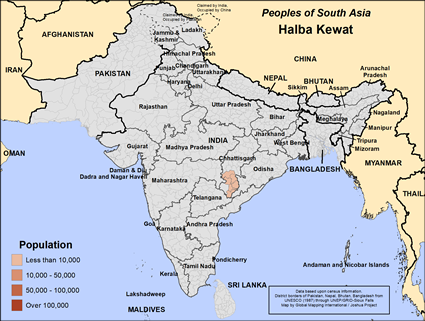Halba Kewat in India

Send Joshua Project a photo
of this people group. |

Map Source:
People Group data: Omid. Map geography: UNESCO / GMI. Map Design: Joshua Project
|
| People Name: | Halba Kewat |
| Country: | India |
| 10/40 Window: | Yes |
| Population: | 4,200 |
| World Population: | 4,200 |
| Primary Language: | Halbi |
| Primary Religion: | Hinduism |
| Christian Adherents: | 0.00 % |
| Evangelicals: | 0.00 % |
| Scripture: | New Testament |
| Ministry Resources: | Yes |
| Jesus Film: | Yes |
| Audio Recordings: | Yes |
| People Cluster: | South Asia Tribal - other |
| Affinity Bloc: | South Asian Peoples |
| Progress Level: |
|
Introduction / History
The Halba Kewat are a small group of indigenous people within a much larger Halba tribal community. The Halba Kewat live central India in the state of Chhattisgarh. The area where they live is considered one of the most beautiful areas of India with dense forests, mountains, waterfalls, caves, and natural parks.
Unfortunately, the literacy level of the Halba is low. The elementary schools in the villages often do not function properly. Halba children frequently leave school early to help their parents make a living working the fields.
The Halba speak their language of Halbi. Some Bible books, the JESUS Film and gospel recordings are available in Halbi. Many of the Halba also speak Hindi so they can communicate with outsiders.
Where Are they Located?
The Halba Kewat live in villages in the east central Indian state of Chhattisgarh.
What Are Their Lives Like?
The primary occupation of the Halba Kewat is agriculture. The grow rice, millet, lentils, wheat, and vegetables. Most families also have chickens, a buffalo, goats, and pigs. For a cash crop the Halba grow cotton, which they dye and weave into blankets, mats and clothing. Elders rule the villages. They decide legal issues and deal with outsiders.
The Halba Kewat mostly marry within their group. Sometimes they will marry within the larger Halba peoples. Families arrange marriages. The newly married couple lives with or near the groom's parents. A bride price is often paid to the bride's family to offset the loss of their daughter. Sons inherit property with the eldest son becoming head of the family upon the death of his father.
As a tribal group, the Halba have their own priests, shrines and shamans. The priests and shamans try to connect the Halba with the invisible world and protect them from evil spirits.
What Are Their Beliefs?
The Halba Kewat practice Hinduism, heavily influence by folk religion. They worship and serve the gods of the Hindu pantheon. Hindus believe that by performing rituals and good works that they will attain moksha or freedom from the endless cycle of birth, death and rebirth. The Halba visit Hindu shrines and offer prayers, food, flowers, and incense to their gods in hopes of gaining protection and benefits. They do not have a personal or familial relationship with their gods like Christians or Jews. There are many forms of Hinduism, each with its own deities and beliefs.
The main yearly holidays of the Halba people are Holi, the festival of colors and the start of spring, Diwali, the festival of lights, Navratri, the celebration of autumn and Rama Navami, Rama's birthday.
What Are Their Needs?
Solar panels could bring electricity to Halba villages. The Halba would greatly benefit by access to modern medicine. Their children will need a secondary education if the Halba are to succeed in the modern Indian economy. Most of all, the Halba need to hear and understand the message of Jesus Christ. He alone can get them right with God and deliver them from their fear of evil spirits.
Prayer Points
Pray for the Holy Spirit to move among Halba Kewat family and community leaders to seek His face and enjoy His blessings.
Pray for the Lord to thrust out workers who will be compelled to nurture a disciple making movement among the Halba Kewat people.
Pray that soon the Halba Kewat people will have faith that is more precious and durable than gold.